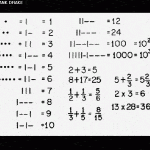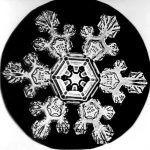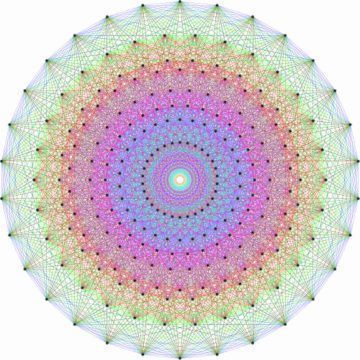by Jonathan Kujawa
I just returned from the joint Vietnam-US math conference held at the International Center for Interdisciplinary Science and Education in beautiful Quy Nhon, Vietnam.

While it is a human endeavor, mathematics doesn’t care about gender, race, wealth, or nationality. One of the great pleasures of the math community is finding yourself on common ground with people from around the world. It is for good reason movie aliens usually first communicate using prime numbers and we chose to include math on the Voyager spacecraft’s Golden Record [1].

In this spirit, the American Mathematical Society and the Vietnamese Mathematical Society organized a joint meeting to encourage connections, collaborations, and friendship between the two countries’ mathematical communities. Given the fraught history between the two countries, the importance and symbolism of the conference were especially notable. During the cold war, even innocuous communication between mathematicians on the two sides was quite difficult. Even sending a letter, nevermind a conference to meet in person, was a rare event. More than a few results were discovered independently on both sides of the Iron Curtain. Progress was often held up due to not knowing of the latest advances on the other side. The Soviet Union, for example, made it difficult for its citizens to participate in the International Congress of Mathematicians. In an age where internationalism and science are treated with skepticism, building direct connections between countries’ citizens is a wonderful thing. The conference even made the local evening news!
Another great thing about these sorts of conferences is the breadth of mathematics covered. This meeting covered everything from topology to mathematical physics, from modeling natural gas flows in pipelines to groups and representations (my own area of research). As part of this, the meeting had six plenary talks by eminent mathematicians covering the various fields represented at the conference.
One of the speakers was Henry Cohn, arguably the world expert on sphere packings. Dr. Cohn gave a fantastic talk about the latest breakthroughs in this area. Nearly three years ago here at 3QD we talked about an amazing breakthrough in sphere packing. This included work by Dr. Cohn. As we’ll see, Dr. Cohn and his collaborators haven’t been napping.
The most basic problem of sphere packing is the question of finding a way to provable fill space as densely as possible with spheres of the same size. In 1D, this is easy: a “sphere” is just a line segment and you can pack the line completely by putting the spheres side-by-side. There will be no gaps and the packing will have density one [2].

In 2D spheres are really just disks in the plane, so sphere packing becomes the problem of arranging pennies on a tabletop so as to fill it as completely as possible with pennies. It is not hard to convince yourself that the best possible arrangement is the one given by the hexagonal lattice: this is where you have rows of pennies, each offset by half a penny’s width so you can nestle the rows as closely as possible. Nature agrees. For example, graphene is nothing but carbon atoms arranged in a hexagonal lattice. Of course, just because both humans and carbon gravitate towards this arrangement doesn’t make it the best possible. It is nontrivial to prove this packing has density π/√12 (approximately 0.9068) and you can do no better.
In three dimensional space, this is the problem of stacking cannonballs or oranges as efficiently as possible. As any gunner or grocer will tell you, the best you can do is to make each layer a hexagonal lattice, and then again offset the layers just enough so the cannonballs/oranges of one level nestle in the low spots of the previous level. It was a major achievement of twentieth-century math when Thomas Hales proved you could do no better than the π/√18 (approximately 0.7404) density of the “cannonball” packing.
You might guess if the 2D case was given by staggering the 1d case and the 3D case was given by staggering the 2d case, then you should be able to get the best packing in 4D by staggering the 3D packing, in 5D by staggering the 4D packing, and so on. However, we have known for quite some time that this doesn’t work. In fact, the densest packings in higher dimensions are deeply mysterious. Using computers we can do experiments and gather data. But even then there are big gaps between our best upper and lower bounds. In fact, we can’t even make a wild guess at what happens in dimensions four, five, six, or seven. To be clear, it’s not we have an intuition for the right answer and we struggle to prove it (like we did in dimensions two and three); rather, we have absolutely no idea what the best packing might even look like.
But a miracle occurs in dimensions eight and twenty-four. As we talked about three years ago, in those dimensions there are highly symmetric lattices which play an important role in number theory, mathematical physics, and numerous other areas of math. It is reasonable to guess that they are so special and so symmetric that they might give us the densest possible sphere packing. And indeed, they do! Dr. Cohn along with Abhinav Kumar, Stephen D. Miller, Danylo Radchenko, and Maryna Viazovska showed the Leech lattice gives the best packing in 24 dimensions. Their result built off of Maryna Viazovska’s earlier work showing the so-called E8 lattice gives the densest packing in 8 dimensions.
What have Dr. Cohn and co. been up to recently? In February of this year the same group released a paper in which they show the E8 and Leech lattices are “universally optimal”. This is an amazing result which makes clear how special these lattices really are.
First, a little background. A potential function is a function which takes in any pair of points in d-dimensional space and gives out a real number which only depends on the distance between the two points. That is, it doesn’t depend on where the two points actually are, only on the distance between them [3].
A perfect example of this is the force due to gravity between two billiard balls. Thanks to Newton’s Law of Universal Gravitation, the force pulling the two billiard together thanks to gravity depends only on the distance between them [4]. The strong and weak nuclear forces, and electromagnetism also give us examples of potential functions. Here is the electromagnetic potential function in action [5]:
Since nature likes to minimize things, you won’t be surprised to learn physicists and chemists are deeply interested in starting with a potential function of some special meaning and then finding configurations of objects which minimize or maximize that potential function.

For example, if you dump a bunch of bowling balls into empty space, then maximizing the gravitational potential functions means minimizing their distances, which is closely related to the problem of finding their densest packing. There are many other situations and many other potential functions one could use. For example, we know from snowflakes that water molecules like to form hexagonal lattices when they are chilled down to below freezing.
Non-water can form crystals in a wide variety of ways. Heck, even water is believed to crystallize into at least 17 different forms of ice (not counting ice-nine). The Crystallization Conjecture is a longstanding open question in physics. This is the problem of showing that, under suitable circumstances, interacting particles will always arrange themselves into periodic configurations at low temperatures. That is, that particles always form into crystals at cold temperatures. This always seems to happen in practice, but we don’t have a good understanding of why.
Said differently, the Crystallization Conjecture is the claim that when a potential function reflects the appropriate physical setup, then it should be minimized when the particles form a lattice.
Cohen and co. prove something really remarkable. Say you start with a “nice” potential function [6]. This isn’t hard to do since many potential functions in nature are nice. For example, the gravitational and magnetic potentials are both nice. Cohen and his coauthors show, for any fixed density in dimensions 8 and 24, the E8 and Leech lattices, respectively, always minimize your nice potential function.
As I alluded to above, one thing you can do is cook up a nice potential function which is minimized exactly when you have a maximally dense sphere packing. In this way, their new result includes the sphere packing problem as a special case. The big difference is that sphere packing only depends on local behavior: the amount of empty space around a sphere is unrelated to what’s going on far away in the packing. With most potential functions we don’t have that luxury. Even when you and I are separated by trillions of light years, gravity gently tugs us towards each other.
What Cohen and coauthors show is that whether you’re trying to maximize a gravity potential between billiard balls, minimize the Coulomb force potential between protons, or whatever crazy (but nice) potential function you might have in mind, the answer is always the E8 lattice in 8D and the Leech lattice in 24D! They do even more. They show that if you have any other periodic configuration which minimizes a nice potential function, then the configuration must essentially be the E8 lattice or the Leech lattice. Not only do they give a minimum configuration, but they give the only minimal configuration in their respective dimensions.
It is a truly remarkable result and shows how special these lattices are. No matter how you measure it, they are singularly tightly packed. In their dimensions, nobody can compare.
That’s the good news. The bad news is physicists and chemists don’t care about dimensions 8 and 24. Like most of us, they mostly care about dimensions 1, 2, 3, and maybe 4.
Shockingly, it was only in 2007 when Henry Cohn and Abhinav Kumar proved the integers minimize every nice potential function in one dimension. It is believed by experts that the Hexagonal Lattice minimizes potential functions in two dimensions. But it is not proven and seems to be quite hard. Two dimensions is already a hard open problem, although at least we have a guess.
In three dimensions it seems even more mysterious. Experimental evidence suggests the minimal configurations may depend on the density you choose and do not even need to be periodic. I, at least, found this surprising. While in principle there is no reason the potential functions must be minimized by a periodic configuration, the potential function only depends on distance and so gives the same values everywhere in space. It would seem reasonable to expect if the potential function is the same everywhere, then so should be the minimal configuration.
Even though it’s a human endeavor, mathematical truth doesn’t care about our preferences. We’ll just have to wait to see what Drs. Cohn, Kumar, Miller, Radchenko, and Viazovska next pull out of their collective sleeve.

[1] Although some of the other images are harder to explain.
[2] By “density” we mean the fraction of space filled by the spheres. So density 1 means space is filled completely by spheres; 0.9 would mean it is 90% spheres, 10% gaps between spheres; etc.
[3] Here and below we’ll mostly be interested in the case when there are infinitely many points. This leads to some technicalities in the math, but they’re easily dealt with so we’ll sweep them under the rug.
[4] Well, it depends on their masses, too, but if we keep the balls the same and only vary their distance, then the force will only depend on the distance.
[5] Video from here.
[6] A nice potential function is one where its even derivatives are always positive and its odd derivatives are always negative. In particular, this means the potential always decreases as the distances get bigger. Nice potential functions include inverse power laws and Gaussians, both of which frequently show up in the real world.
